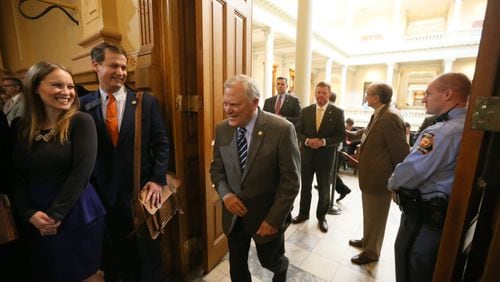Georgia lawmakers raised the alarm earlier this year when they had to provide an extra $223 million to ensure the financial security of the state’s massive teacher pension system.
The Atlanta Journal-Constitution has learned that next year the government may have to put in almost twice that amount, eating up much of the new revenue the state expects to take in to pay for increased public health care and education costs, and possibly teacher pay raises.
The Teacher Retirement System's board recently voted to increase the "employer," or government, contribution rate to the fund by almost 25 percent starting July 1 of next year. That rate — a percentage of employee payroll — will have more than doubled since 2012.
State officials will factor that into the budget lawmakers have to vote on during the 2018 General Assembly session, which begins in January.
State officials are estimating the bump could require an additional $375 million to $400 million contribution by taxpayers into the fund — on top of the more than $1.5 billion a year paid in now. That’s likely the largest one-year infusion of money into the program ever.
In recent years, much of the increase in tax collections as the economy grew was eaten up by rising enrollment in public health care programs and schools, and in the rising cost of those services.
Lawmakers won't be in session for another seven months, and Gov. Nathan Deal's budget staff hasn't yet given state agencies instructions on how to develop their spending proposals. But House Appropriations Chairman Terry England, R-Auburn, said the rising pension payments may have an impact.
“It will just mean that there are some things we may have wanted to do that we won’t be able to do,” England said. That could include a year without pay raises, or smaller increases, for Georgia’s 200,000 teachers and state employees.
The $400 million that would go into the rising payments would have been enough to provide teachers with their biggest raises since at least the 1990s, and it would have been more than twice what’s needed to fill holes left by “austerity cuts” that have been included in education budgets for more than a decade.
But teachers say the money is worth it to the state because the pension system is a great recruiting tool that attracts educators and keeps the best on the job for decades. Some lawmakers, on the other hand, would like to see the state offer portable, 401(k)-like plans for new teachers rather than solely pensions, which guarantee a monthly income for life.
Any attempt to alter the current system — which covers about 400,000 teachers, University System of Georgia employees and retired educators — causes a political stir at the Capitol. Proposals have typically been beaten down before they can get traction. States across the country have had to subsidize pension plans to prop them up in recent years, draining resources from other areas of their budgets, fiscal experts say. Some states and municipalities have run huge shortfalls for reasons ranging from general underfunding to poor investment performances, from declines in employees paying into systems to big increases in retirees taking money out of them.
The $70 billion Georgia system is funded through a combination of contributions from employees and employers (school districts, public colleges, state agencies, etc.), as well as investment income. The pensions that teachers and employees receive are based on the highest income they earned over a period of time and the years they worked. Statewide, the average TRS payout last year to the 117,918 retirees in the system was about $36,000. TRS reports show the number of people receiving pension benefits is rising.
The system had 84 percent of its pension liability covered in 2014. At the end of 2016, that had fallen to 76 percent, still better than many state pension plans.
Buster Evans, the system's executive director, said the projected increase in taxpayer funding "is really one of those things that has been building over time."
The Great Recession greatly set back the system, which counts on a certain rate of return on investments. The system hasn’t fully recovered from those losses, Evans said. Also, the number of teachers and employees contributing to the fund had dropped by about 15,000 at one point because jobs were cut or positions went unfilled. While some of those teaching and state jobs have since returned, Evans said there are still about 8,500 fewer active workers paying into the fund than there were in 2009.
The TRS board also adopted a schedule to gradually lessen the fund’s unfunded liability — what it owes in payouts versus the assets of the fund. “You’re paying more money now, but down the road you will see that drop to a very low employer contribution rate,” he said.
In fiscal 2011, the government paid 9.74 percent of payroll into the TRS. That rate will be 20.9 percent in fiscal 2019, which begins July 1, 2018.
Georgia House Budget and Fiscal Affairs Oversight Chairman Chuck Martin, R-Alpharetta, does not think the system is sustainable for the state.
“It’s not fiscally responsible from the state’s perspective not to to look at other options,” Martin said.
Martin, like state Sen. Hunter Hill, R-Atlanta, a candidate for governor in 2018, said he'd like to see the state consider changing the program so that new staffers would be offered something like 401(k)s or a hybrid plan, rather than only the traditional pension. In a 401(k) plan, the government would contribute to an investment fund that employees could take with them if they switched jobs. Martin said current teachers and state employees in the TRS would see no change in their benefits.
Such a plan, he said, would be more attractive to teachers or staffers fresh out of college who may not want to teach 25 to 30 years in state schools.
“A lot of people don’t stay in the same job,” he said. “This would give them more options.”
But Martin also called the state’s retirement systems the “third rail” of Georgia politics. Touch them and a politician can get fried.
Teachers worry that changing the system as Martin suggests would further reduce the number of employees helping to fund the system, making it more financially and politically vulnerable.
John Palmer, a Cobb County educator and spokesman for the teacher group TRAGIC, said TRS members have a right to be skeptical of any plans after what he called more than a decade of underfunding of schools by the state.
“At first, it was ‘temporary’ austerity cuts, which robbed our local school districts of billions of dollars,” he said. “Now the state is playing a funding shell game by shifting those austerity cuts into increased costs for transportation, health care and now retirement benefits.
“These funding shifts place an ever-increasing burden on our local school districts as our legislators try and balance the state budget on the backs of our teachers and children.”
GOVERNMENT AND POLITICAL NEWS
If it happens in Washington or under the Gold Dome, The Atlanta Journal-Constitution has somebody there to tell you what it means for all Georgians. Follow our coverage at http://www.myAJC.com/politics.
You can also join the conversation on Twitter at http://Twitter.com/GAPoliticsNews or Facebook at http://facebook.com/gapoliticsnewsnow/.
About the Author








